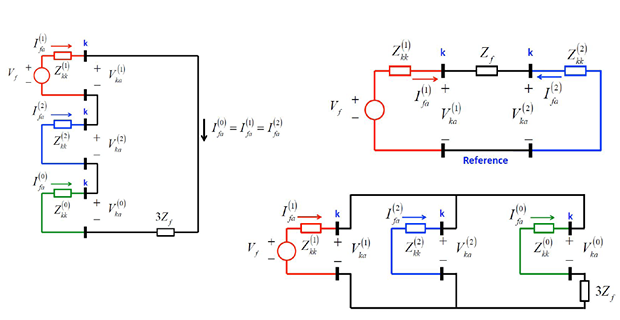Unsymmetrical Faults Solved Problems
Demonstrative Video
Revision of important Concepts

Problem-1
A 25 MVA, 13.2 kV alternator with solidly grounded neutral has a sub-transient reactance of 0.25 pu. The negative and zero sequence reactance are 0.35 and 0.1 pu, respectively. A single line to ground fault occurs at the terminals of an unloaded alternator. Neglecting resistance, determine
the fault current and the line-to-line voltages.
Solution-1
Let the line-to-neutral voltage at the fault point before the fault be \(1.0+j0.00\) p.u.
For LG-fault, the \(Z_f\) is \(j0.25+j0.35+j0.1=j0.7\)
- \[I_{a1} = I_{a2} = I_{a0} = -j1.428\]For a L-G fault:
- \[\begin{aligned} I_a & = I_{a1} + I_{a2} + I_{a0} \\ & = 3I_{a1} = -j4.285 \end{aligned}\]The p.u. fault current
Let base be 25 MVA and 13.2 kV
\(I_b=\dfrac{25 \times 1000}{\sqrt{3} \times 13.2} = 1093~A\)
The actual fault current = \(1093 \times 4.285=4685~A\)
- \[\begin{aligned} V_{a1} & = E_a - I_{a1}\cdot Z_1\\ & = 1-(-j1.428)(j0.25)\\ & = 0.643\\ V_{a2} & = -I_{a2}Z_2 = -(-j1.128)(j0.35)\\ & = -0.4998\\ V_{a0} & = -I_{a0}Z_0\\ &= - (-j1.428)(j0.1)=0.1428 \end{aligned}\]To find out the voltages, first compute sequence components of voltages
As a numeric check \(V_a = V_{a1}+V_{a2} + V_{a0} =0\)
\(V_{b}=V_{b1}+V_{b2}+V_{b0}\) and \(V_{c}=V_{c1}+V_{c2}+V_{c0}\)
- \[\begin{aligned} V_{a b} &=V_{a}-V_{b} . \text { since } V_{a}=0 \\ V_{a b} &=-V_{b}=0.2143+j 0.9898 \\ V_{a c} &=-V_{c}=0.2143-j 0.9898 \\ V_{b c} &=V_{b}-V_{c}=-j 2 \times 0.9898 \\ &=-j 1.9796 \end{aligned}\]Now, Line-to-Line voltage are:
- \[\begin{aligned} V_{a b} &=0.2143+j 0.9898 \\ |V_{a b}|&=1.0127 \mathrm{p} \cdot \mathrm{u} \end{aligned}\]Now
- \[\begin{array}{l} V_{a b}=1.0127 \times \frac{13.2}{\sqrt{3}}=7.717 \mathrm{kV} \\ V_{a c}=7.717 \mathrm{kV} \\ V_{b c}=1.9796 \times \frac{13.2}{\sqrt{3}}=15.08 \mathrm{kV} \end{array}\]The Line-to-Line voltage will be
Problem-2
Determine the fault current and the line-to-line voltage at the fault when a line-to-line fault occurs at the terminals of the alternator described in the Previous question.
Solution-2
- \[\begin{array}{l} I_{a_{1}}=-I_{a_{2}}=-j 1.667 \\ I_{a_{2}}=j 1.667 \\ I_{a_{0}}=0 \end{array}\]For LL fault
- \[\begin{aligned} I_{b} &=I_{b_{1}}+I_{b_{2}}+I_{b_{0}}=I_{b_{1}}+I_{b_{2}}=\lambda^{2} I_{a_{1}}+\lambda I_{a_{2}} \\ &=(-0.5-j 0.866)(-j 1.667)+(-0.5+j 0.866)(j 1.667) \\ &=j 0.833-1.4436-j 0.833-1.4436 \\ &=-2.8872 \mathrm{p} \cdot \mathrm{u} \end{aligned}\], use To find out the fault current,
we know \(I_b=1093~A\)
Fault current \(=1093 \times 2.8872=3155.71\) amperes
- \[\begin{aligned} V_{a_{1}} &=E_{a}-I_{a_{1}} Z_{1}=1+j 0.0-(-j 1.667)(j 0.25) \\ &=1-0.4167=0.5833 \\ V_{a_{2}} &=-I_{a_{2}} Z_{2}=(-j 1.667)(j 0.35)=0.5834 \\ V_{a_{1}} &=V_{a_{2}}=0.5833 \mathrm{p} \cdot \mathrm{u} \\ V_{a} &=V_{a_{1}}+V_{a_{2}}+V_{a_{0}}=V_{a_{1}}+V_{a_{2}}=2 \times 0.5833=1.1666 \mathrm{p} . \mathrm{u} . \\ V_{b} &=\lambda^{2} V_{a_{1}}+\lambda V_{a_{2}} \\ &=(-0.5-j 0.866)(0.5833)+(-0.5+j 0.866)(0.5833) \\ &=-0.5833 \\ V_{b} &=V_{c}=-0.5833 \end{aligned}\]To find out L-L voltage, find sequence voltages:
- \[\begin{array}{l} V_{a b}=V_{a}-V_{b}=1.1666-(-0.5833)=1.7499 \\ V_{a c}=V_{a}-V_{c}=1.7499 \\ V_{b c}=V_{b}-V_{c}=0.0 \end{array}\]Line voltages
- \[\begin{array}{l} V_{a b}=1.7499 \times \frac{13.2}{\sqrt{3}}=13.33 \mathrm{kV} \\ V_{a c}=13.33 \mathrm{kV} \\ V_{b c}=0.0 \mathrm{kV} \end{array}\]L-L voltages
Problem-3
Determine the fault current and the line-to-line voltages at the fault when a double line-to-ground fault occurs at the terminals of the alternator described in the previous question
Solution-3
- \[\begin{aligned} I_{a_{1}} &=\frac{E_{a}}{Z_{1}+\frac{Z_{0} Z_{2}}{Z_{0}+Z_{2}}}=\frac{1+j 0.0}{j 0.25+\frac{j 0.1 \times j 0.35}{j 0.45}}=\frac{1+j 0.0}{j 0.25+j 0.0778} \\ &=\frac{1+j 0.0}{j 0.3278}=-j 3.0506 \mathrm{p.u} \end{aligned}\]Compute
- \[\begin{array}{l} V_{a_{1}}=V_{a_{2}}=V_{a_{0}} \\ V_{a_{1}}=E_{a}-I_{a_{1}} Z_{1} \end{array}\]For LLG fault
To find out \(I_{a2}\) and \(I_{a0},\) we should first find \(V_{a1}\)
Since \(V_{a_{1}}=V_{a_{2}}=-I_{a_{2}} Z_{2}, I_{a_{2}}\) can be obtained.
Similarly, \(V_{a_{1}}=V_{a_{0}}=-I_{a_{0}} Z_{0}, I_{a_{0}}\) can be obtained.
Fault current \(=I_{b}+I_{c}=3 I_{a_{0}}=3 \times j 2.374=j 7.122 \mathrm{p} . \mathrm{u} .\)
- \[1093 \times 7.122=7784.3 \text { amperes }\]Since base current is 1093 amperes, the fault current will be
- \[\begin{array}{l} V_{a}=V_{a_{1}}+V_{a_{2}}+V_{a_{0}}=3 V_{a_{1}}=3 \times 0.2374=0.7122 \\ V_{b}=V_{c}=0 \end{array}\]Now,